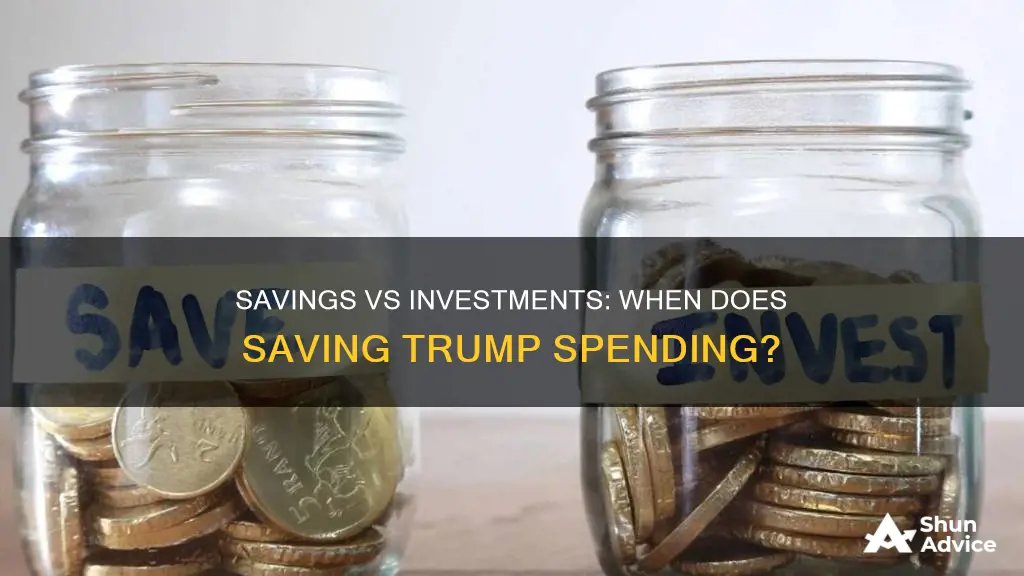
When planned savings exceed planned investments, it indicates that expenditure in the economy is less than what producers had expected. This results in an undesired buildup of unsold stock, causing a fall in aggregate demand (AD) below aggregate supply (AS). To address this imbalance, producers cut down on employment and production, leading to a decrease in national income. Consequently, planned savings start declining until they become equal to planned investments, restoring equilibrium in the economy. This equilibrium, where planned savings match planned investments, is crucial for maintaining constant output, income, employment, and price levels.
| Characteristics | Values |
|---|---|
| Planned savings | 25,000 crore |
| Planned investment | 20,000 crore |
| Expenditure in the economy | Less than what producers expected |
| Inventory | Undesired build-up of unsold stock |
| AD | Falls short of AS |
| Supply | Excess |
| Employment | Cut down |
| Output | Reduced |
| Income | Falls |
What You'll Learn

There is an undesired build-up of stock
When planned savings exceed planned investment, an undesired build-up of stock occurs. This happens when there is less expenditure in the economy than what producers had expected. This results in an excess of stock that remains unsold, leading to a situation where Actual Demand (AD) falls short of Actual Supply (AS).
The build-up of unsold goods, or unintended inventories, prompts producers to reduce employment and decrease production. This, in turn, leads to a decline in national income, which then results in a decrease in planned savings. This cycle continues until planned savings and planned investment are equal, allowing the economy to reach an equilibrium level of income.
In this context, it is important to distinguish between planned and actual savings and investment. Planned savings refer to the amount that households in an economy intend to save over a specific period, typically a year. On the other hand, planned investment represents the amount that firms or entrepreneurs plan to invest during the same period. Actual savings and investment, however, are the realised amounts after the fact.
The equilibrium in the economy is achieved when planned investment and planned savings are equal. This equilibrium is rare because savers and investors have different motives and intentions. When planned savings and planned investment are not equal, the output will adjust up or down until they become equal again. This adjustment mechanism helps to stabilise the economy and prevent prolonged imbalances between supply and demand.
Saving and Investing: Strategies for Future Financial Goals
You may want to see also

Aggregate demand falls short of aggregate supply
When planned savings exceed planned investment, it indicates a situation where aggregate demand (AD) falls short of aggregate supply (AS). This occurs when there is an excess of planned savings over planned investment, resulting in lower-than-expected expenditure in the economy. Consequently, producers experience an undesired build-up of unsold stock, leading to a decrease in output and income. This, in turn, causes a reduction in employment and production. The economy adjusts to this imbalance by decreasing national income, which aligns planned savings and planned investment, ultimately achieving equilibrium.
The relationship between planned savings and planned investment is crucial for understanding the dynamics of an economy. When these two components are equal, the economy reaches a state of equilibrium, where output, income, employment, and price levels remain constant. However, in reality, it is rare for planned savings and planned investment to be exactly equal due to differing motives among savers and investors.
When planned savings exceed planned investment, the economy experiences an imbalance. This excess of planned savings leads to a decrease in aggregate demand, as consumers opt to save more and spend less. As a result, producers are left with an excess of unsold goods, causing a decrease in output and a build-up of inventories. This situation can be detrimental to the economy, as it leads to a downward spiral of decreasing income, employment, and production.
To address this imbalance, producers may take steps to reduce the excess inventory. They may choose to expand their output, which, in turn, increases income. This rise in income leads to an increase in aggregate demand, as consumers have more money to spend. As a result, the excess inventory is gradually reduced, bringing planned savings and planned investment closer to equilibrium.
It is important to note that actual savings are always equal to actual investment. This is because actual investment includes both planned investment and unintended investment, which accounts for changes in inventory. Therefore, even if planned savings and planned investment are not equal, the economy self-corrects through adjustments in inventory levels, ensuring that actual savings match actual investment.
From Saving to Investing: Strategies for Your Financial Journey
You may want to see also

Producers cut down on employment
When planned savings exceed planned investment, there is an undesired build-up of unsold stock. This is because expenditure in the economy is less than what producers had expected. Consequently, producers will cut down on employment and produce less.
The build-up of unsold stock means that AD (aggregate demand) falls short of AS (aggregate supply). This excess supply results in the unintended accumulation of inventories. In other words, the planned inventory falls below the desired level.
To address this imbalance, producers will reduce their output, which leads to a decrease in national income. As a result, planned savings will also start to fall until they eventually become equal to planned investment. This point of equality between planned savings and planned investment is where the equilibrium level of income is determined.
It is important to note that equilibrium in the economy occurs only when planned investment and planned savings are equal. This equilibrium is rare because savers and investors have different motives and intentions. According to Keynes, it is the discrepancy between planned savings and planned investment that causes fluctuations in output, income, and employment levels.
Therefore, when planned savings are greater than planned investment, producers will cut down on employment as part of the adjustment process to restore equilibrium in the economy.
Savings, Spending, and Investment: Understanding the Interplay
You may want to see also

National income falls
When planned savings exceed planned investments, it means that expenditure in the economy is less than what producers had expected. This results in an undesired buildup of unsold stock, causing a fall in national income.
This situation, where planned savings are greater than planned investments, leads to a decrease in aggregate demand (AD) compared to aggregate supply (AS). The excess supply results from the stockpiling of unsold goods, which are considered unintended inventories. As a result, producers will reduce employment and produce less, causing a further decline in national income.
To address this issue, producers will aim to bring inventory levels back to the desired state. They will expand output, leading to increased income. This, in turn, will lead to a rise in planned investment, as producers invest more to meet the increased output. Consequently, national income will increase, leading to a rise in planned savings until savings and investments are equal.
According to Keynes, it is the discrepancy between planned savings and planned investment that causes fluctuations in output, income, and employment levels. To maintain equality between the two, he suggested the use of fiscal policy. For instance, if private investment declines, leading to a fall in income and employment, the government should step in by increasing its expenditure on public works. Conversely, if private investment surpasses private savings, even after full employment, the government should consider increasing taxes and reducing public expenditure.
Investment Surpassing Savings: A Recipe for Economic Growth or Debt?
You may want to see also

Planned inventory falls below the desired level
When planned savings exceed planned investments, there is an undesired build-up of unsold stock, causing the planned inventory to fall below the desired level. This discrepancy between savings and investments indicates that expenditure in the economy is less than what producers had expected. Consequently, there is a reduction in consumption and aggregate demand in comparison to aggregate supply.
To address this issue, producers will take measures to increase output, which, in turn, will lead to higher income. This rise in output and income will result in an increase in planned investment. As planned investment rises, the gap between planned savings and planned investment will narrow. This adjustment process will continue until equilibrium is reached, where planned savings and planned investment are equal.
The accumulation of inventories occurs when planned investment falls short of planned savings. In this scenario, the stock of goods tends to pile up, leading to an excess supply of goods beyond what consumers are purchasing. This imbalance between supply and demand can have further economic implications, such as adjustments in production, income, and employment levels.
It is important to note that equilibrium in the economy is only achieved when planned investment and planned savings are equal. This equilibrium is rare because savers and investors have different motives and intentions. However, actual savings and actual investments are always equal at all levels of income, as savings finance investments.
In summary, when planned savings exceed planned investments, it disrupts the desired inventory levels and triggers a series of economic adjustments. Producers respond by increasing output, which leads to higher income and planned investment. This feedback loop continues until equilibrium is reached, where planned savings and planned investment are balanced.
Graph Savings: A Smart Investment Strategy?
You may want to see also
Frequently asked questions
Inventories will accumulate and the planned inventory would fall below the desired level.
There is an undesired build-up of unsold stock. Consequently, AD falls short of AS. Due to excess supply, producers will cut down on employment and produce less. National income will fall and as a result, planned saving will start falling until it becomes equal to planned investment.
Saving is always equal to actual investment in economic terms, as it encompasses both planned and unintended investment.
Planned saving is the savings which are intended to be made by all the households in the economy during a period (say, a year) at the beginning of the period. Planned investment is the investment which is planned or desired to be made by firms or entrepreneurs in the economy during a period.







